Making of Mountain Retreat
I first learned about studio xoio following their co-founders, Lasse Rode, post about Casa Barragan at the forums. Browsing their portfolio, one image in particular captured my attention. Mountain Retreat was created to be used as a new years postcard and a great one it is! I just had to ask Lasse to be kind enough and write an article about it. Here it is Enjoy!
 Author: Lasse Rode / Studio xoio
Author: Lasse Rode / Studio xoioThe Berlin based studio xoio has been established in 2006 by Peter Stulz and Lasse Rode. It is specialized in high-quality emotive architecture and product visualization. The team at xoio consists of people which have an architecture and design background. That provides a strong understanding of creative processes and the ability to give support in questions of design.
Introduction
We would like to say thank you and how much we feel honored to be given the opportunity writing this making-of.
The Mountain Retreat image we would like to talk about is some piece of work we did as our 2010 new years postcard, After having a helicopter, Christmas tree and something abstract in the past few years.
We thought it would be good to make something more with in the realm of architectural visualization, as this is what we are used to do most of the time. So we did, and after some discussion and research for nice winter images we decided it to be a small house within a winter snow-covered valley beneath a lake.
Modeling
Modeling this project was not the hard side part. There are very few complex objects and everything is modeled in a conventional way. But let’s have a look at the environment, as this is something that really dominates the image.
Up above you can see how the environment is built. There are the house and 5 planes. One in the foreground, the lake, one plane in the background for the snow field, and two for the mountains in the back which are slightly deformed by pulling on their vertices to give them a rough form.
After that the mountain on the right gets a simple 3dsmax noise modifier to give it a less smooth look, but not detailed too much because this one will be covered by trees later on.
On the mountain in the back we applied a standard displace modifier with a relief-map in the map slot. This map gives a more detailed rocky look because this one will be visible in the end.
That map looks something like this
We created it using World Machine 2.0. It is a node-based tool to create terrains in a very intuitive way. You can export all necessary maps from it to create cool looking mountains.
After being done with this we added some bushes in the foreground, put some weeds in the lake and scattered some trees in the background with the awesome Forest plugin by iToo Software. The pyramids you can see here show the forest-proxies and as you can see we only used 4 different types of trees. This was enough to simulate a forest.
Snow
OK, let’s have a look at the snow.
Basically, there are five points which make this image look like winter
1. The Snow Material
The material we used for the snow is a very simple V-Ray shader. We applied it on everything which is covered by or really is snow.
It looks like this
And here are the settings for it
2. The Icicles
We modeled some icicles to add it at some spots on the house. It is a very simple model with a simple refractive material. The mesh looks like this
2. Snow on the rooftop, boat and the bushes
For creating the snow on the rooftop we created a standard PFlow system. This PFlow System scatters particles on the horizontal (selected) faces of the roof.
After that we applied the Particle Wrapper Plugin available from 3daliens.com. It is a very neat tool to mesh particle-flow geometry. This should look like this
After that we paint-deformed on it with the standard 3dsmax paint-deform tool in the edit Poly object options.
We used the same technique to make the snow on the boat and on the bushes in the foreground.
Just the 3 steps – Create Particles on desired faces, Wrap them, Paint-deform them to get a more realistic feel.
4. Snow on trees.
For the snow on the trees we used a very old-school technique – the top/bottom material.
This is the one for the needles for instance
You can mix the normal material with the snow and tell the shader to be only on the top-side of the object, just as snow does. This works fine for the trees which are quite far away.
5. Footsteps and other detail
We also applied a V-Ray Displacement modifier on the ground in the foreground to make the footsteps and the trails in the snow. We painted a map for this that looks like this
This is quite nice for adding some detail to the snow in some spots.
Lighting
Here you can see what lights are used and what kind they are. There are some V-Ray IES lights for the interior of the house, spotlights for the snow-mobile, V-RayLights for the garden lamps and a domelight with a nice blue HDRi for global lighting.
Fog
For the fog we used a simple standard fog (not V-Ray fog) with default settings except the density which is a noise-map to allow for fog variations in density. We’ve put an instance of the HDRi map we used on the domelight in the environment color slot as well.
Render
The renders settings are nothing special. They look like the ones everybody uses I guess.
Postwork
After that we did some post work. Not much, just some basic color-corrections and some fog hovering above the trees and the lake. The Fog above the lake is simply painted in Photoshop with a standard brush-tool, as well as the smoke from the chimney. You can see the process in the animated image below and single steps after it.
Here are the individual image steps for your review
Well we hope you can use some of these techniques in your future work and thank you for reading.
Peter + Lasse from xoio
You are welcome to comment on this article and ask questions using the comment box below!




































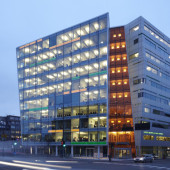
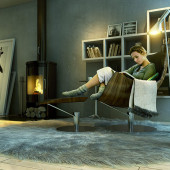
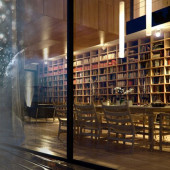
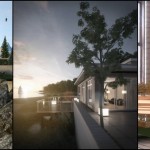
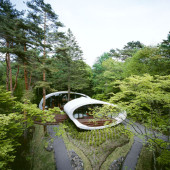
That’s probably the best ‘making of’ articles written on winter scene setup! Amazing!!!
great making of.
Thank you.
Lovely making of with so much detail, even a beginner with some basics could catch up with this…lovely and thanks….i think everyone doing a making of should probably see this before doing theirs. Cheers
ive seen that pic at 3dmax.de, and now im surprised how that works. thanks for that big making of.
fantastic ¡¡¡¡ just one question , the sky ? how did you solved ?
thanks
hey guys,
glad you like our little making-of.
the sky basicly is an hdri-map applied to the domelight that is used for global lighting. You might have a look at peter guthrie’s blog where he explains this technique very good. it is a very effective way to lighten exterior-scenes.
best regards
Lasse
xoio
A very thorough making of such a beautiful image, this will come in very handy, thanks for sharing your technique!
Hi, Lasse.
This is a great making-of article. Every time I see a 3D rendering, the first thing I see is magic. It is only when somebody offers an article such as this when I see the hard work behind the magic and that makes the rendering even more special.
Thanks for sharing this wonderful article. 🙂
Enjoy the rest of your week,
Kim.
amazing style
HiLasse…great work…simple steps with amazing outputs…Bravo !!
VERy